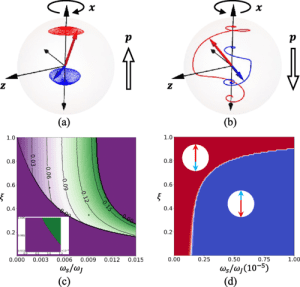 Ferrimagnetic materials (FIMs) can function as high-frequency antiferromagnets while being easy to detect as ferromagnets, offering unique opportunities for ultrafast device applications. While the physical behavior of FIMs near the compensation point has been widely studied, there lacks a generic understanding of FIMs where the ratio of sublattice spins can vary continuously between the ferromagnetic and antiferromagnetic limits. PI-Cheng’s group investigated a series of physical properties of two-sublattice FIMs driven by magnetic fields and current-induced torques. By varying the ratio of sublattice spins, PI-Cheng’s group clarified how the dynamical chiral modes in a FIM are physically connected to their ferromagnetic and antiferromagnetic counterparts, based on which unique features not visible near the compensation point are demonstrated. It is found that current-induced torques can trigger spontaneous oscillation of the terahertz exchange mode (i.e. mimicking a THz antiferromagnet). Compared with its realization in antiferromagnets, a spin-torque oscillator using FIMs not only has a reduced threshold current density but also can be self-stabilized, obviating the need for dynamic feedback.
Ferrimagnetic materials (FIMs) can function as high-frequency antiferromagnets while being easy to detect as ferromagnets, offering unique opportunities for ultrafast device applications. While the physical behavior of FIMs near the compensation point has been widely studied, there lacks a generic understanding of FIMs where the ratio of sublattice spins can vary continuously between the ferromagnetic and antiferromagnetic limits. PI-Cheng’s group investigated a series of physical properties of two-sublattice FIMs driven by magnetic fields and current-induced torques. By varying the ratio of sublattice spins, PI-Cheng’s group clarified how the dynamical chiral modes in a FIM are physically connected to their ferromagnetic and antiferromagnetic counterparts, based on which unique features not visible near the compensation point are demonstrated. It is found that current-induced torques can trigger spontaneous oscillation of the terahertz exchange mode (i.e. mimicking a THz antiferromagnet). Compared with its realization in antiferromagnets, a spin-torque oscillator using FIMs not only has a reduced threshold current density but also can be self-stabilized, obviating the need for dynamic feedback.
This article has been published in Physical Review B and is available here.
